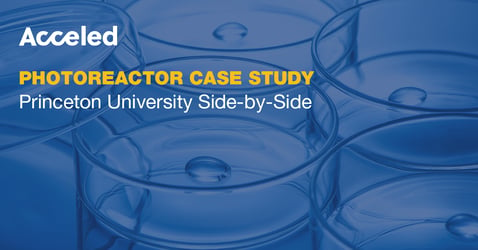Proteomics is an important field of study because of proteins’ involvement in almost every biological process. Through proteomics, researchers hope to gain a better understanding of things like disease mechanisms, drug targets, and biomarker diversity. Proteomics is rapidly evolving, and providing researchers with the correct tools can lead to better discoveries in medicine, biotechnology, and basic research.
While not a core aspect of proteomics, photocatalysis can be a valuable tool. Photoreactors can be used to study protein-protein interactions using a photoactivatable crosslinker and be used to modify proteins for structural analysis.
Keeping in line with Acceled’s goal to further discovery wherever we can, our photoreactors continue to contribute to proteomics research.
Acceled’s Photoreactor m2 in Proteomics Research
Tracking chromatin state changes using nanoscale photo-proximity labelling
A lack of technologies that can observe protein-protein interactions without breaking them can make it difficult to study these interactions in complex environments. However, researchers have discovered a method of traceless incorporation of molecules called iridium-photosynthesizers. These molecules can be used for analysis in chemo proteomics.
Using this method, researchers revealed important interactions between cancer cells when treated with certain drugs. This discovery is expected to have significant effects on epigenetic drug discovery and improve our overall understanding of nuclear protein-protein interactions.

Discover how Acceled’s Photoreactor m2 outperforms competing photoreactors in this side-by-side, Princeton University case study.
Diselenide-selenoester ligation in the chemical synthesis of proteins
Proteins and peptides are important biomolecules that play a plethora of roles inside living things. These molecules are often post-translationally modified, creating a proteome that is larger than the number of genes a given living organism has. Accessing these peptides and proteins is crucial for researchers to understand their functional role.
Researchers used a method called diselenide-selenoester ligation (DSL) for the chemical synthesis of modified proteins – allowing researchers to study how these proteins function and test new treatments for disease.
Photocleavable Approaches for Reversible Bioconjugation
The way that peptides and proteins are shaped depends on the way their building blocks (called the amide backbone) are arranged. Scientists have used a technique called photocaging to control how proteins fold and work by adding light-sensitive parts to the side of the protein. However, researchers were able to insert a traceless photocage into the backbone using copper-mediated modification.
This required a photocleavage reaction that hadn’t been reported before, and the light-sensitive molecules needed to be soluble in water and function with visible or near-infrared light. The new backbone photocaging reagents can control protein folding and enzyme activity using UV, blue, and near-IR light, and can modify model proteins. This is an exciting development that opens possibilities for creating many more types of backbone photocages to study different proteins in different contexts.
Acceled’s goal is to equip researchers with the tools to accelerate their discovery. See the latest in our photocatalysis technology and improve photoreactor performance by 3x the original light intensity:



